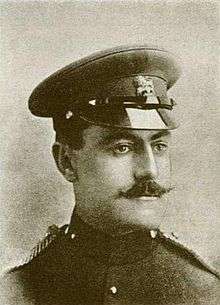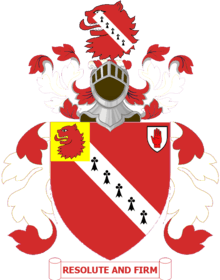Sir John Milbanke, 10th Baronet
Lieutenant-Colonel Sir John Peniston Milbanke, 10th Baronet, VC (9 October 1872 – 21 August 1915) was a British Army officer, and a recipient of the Victoria Cross, the highest award for gallantry in the face of the enemy that can be awarded to British and Commonwealth forces.
Sir John Peniston Milbanke, Bt | |
|---|---|
 | |
| Born | 9 October 1872 Belgravia, London |
| Died | 21 August 1915 (aged 42) Suvla, Gallipoli, Ottoman Turkey |
| Allegiance | |
| Service/ | |
| Years of service | 1892–1910 1914–1915 |
| Rank | Lieutenant Colonel |
| Unit | 10th Hussars Sherwood Rangers Yeomanry |
| Battles/wars | Second Boer War World War I |
| Awards | |
Milbanke was born the son of Sir Peniston Milbanke, 9th Baronet, in London.[1] In 1886, he began attendance at Harrow School, where he became a close friend of Winston Churchill. He was commissioned as a second lieutenant in the 10th Hussars on 23 November 1892, and promoted to lieutenant on 18 April 1894.[2] Following the outbreak of the Second Boer War, Milbank was posted to South Africa as Aide-de-camp to Lieutenant-General Sir John French.[3]
Milbanke was 27 years old, serving as a lieutenant in the 10th Hussars during the Second Boer War, when the following deed took place near Colesberg for which he was awarded the VC:
On the 5th January, 1900, during a reconnaissance near Colesberg, Sir John Miibanke, when retiring under fire with a small patrol of the 10th Hussars, notwithstanding the fact that he had just been severely wounded in the thigh, rode back to the assistance of one of the men whose pony was exhausted, and who was under fire from some Boers who had dismounted. Sir John Miibanke took the man up on his own horse under a most galling fire and brought him safely back to camp.[4]
Promoted to captain on 17 April 1900, he served in South Africa until the end of hostilities when peace was declared in June 1902. He left Cape Town on board the SS Walmer Castle in late June 1902,[5] and arrived at Southampton the following month. In early October 1902 he returned to his regiment as it was posted to Mhow in British India.[6]
In 1914, having retired from the regular army, he became lieutenant-colonel of the Sherwood Rangers. He was killed in action at Suvla, Gallipoli, Turkey, on 21 August 1915 and is commemorated on the Helles Memorial.[7]
The Medal
His Victoria Cross is displayed at The King's Royal Hussars Museum in Winchester, England.
 |
|
See also
- Milbanke Baronets
References
- "Anglo Boer War.com". Retrieved 17 January 2013.
- Churchill, Randolph Spencer (1966). The Young Churchill. Spencer Books. p. 24. Retrieved 28 July 2009.
- Hart´s Army list, 1903
- "No. 27208". The London Gazette. 6 July 1900. p. 4196.
- "The Army in South Africa - Troops returning home". The Times (36811). London. 4 July 1902. p. 9.
- "No. 27481". The London Gazette. 10 October 1902. p. 6410.
- CWGC entry
- Burke's Peerage. 1959.
- Monuments to Courage (David Harvey, 1999)
- The Register of the Victoria Cross (This England, 1997)
- Victoria Crosses of the Anglo-Boer War (Ian Uys, 2000)